

|
|
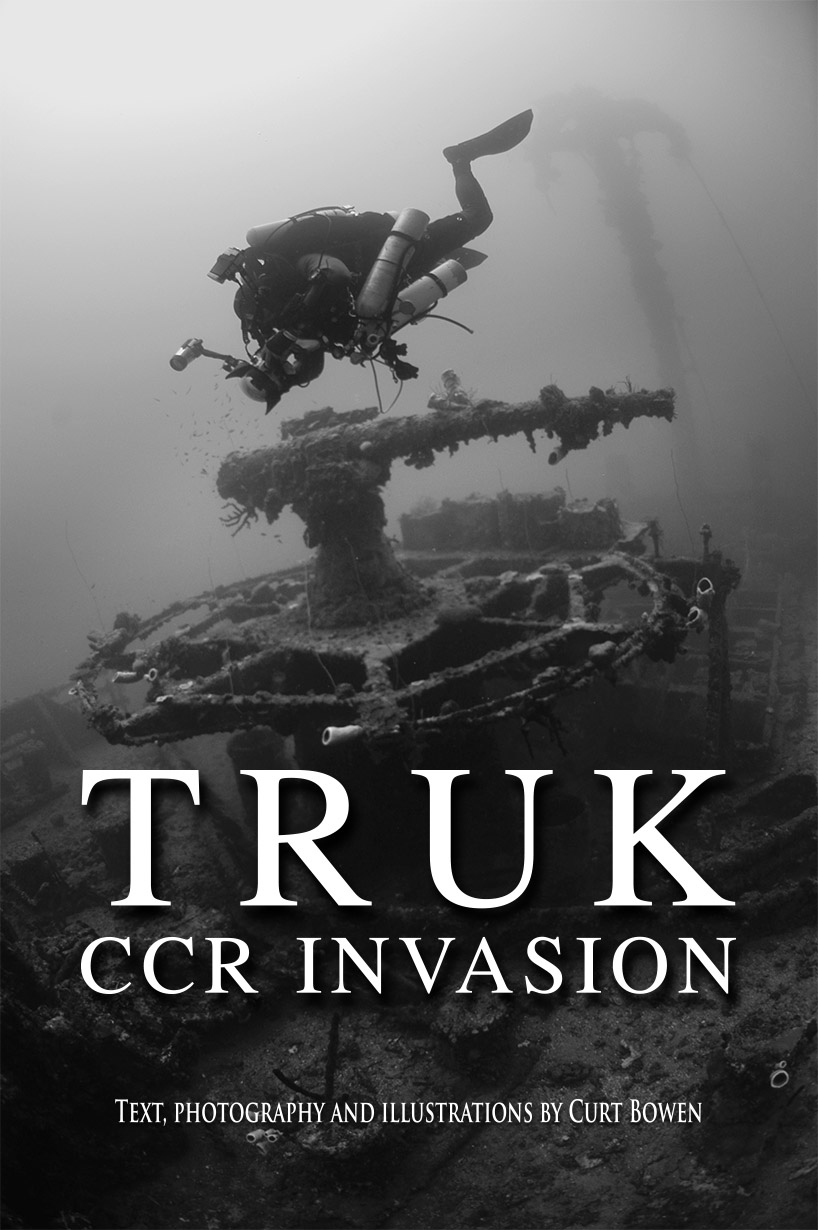 |
| |
A second invasion hailed down upon the world famous Truk Lagoon as a group of technical CCR divers, headed by Going Under Dive Center’s Ron Benson, coordinated a 10-day closed circuit rebreather only assault on the sunken Japanese fleet. The use of CCR’s enabled divers to conduct dives upon some of the more remote, deeper wrecks, doubled normal open circuit bottom times, and greatly cut down on outrageous helium and oxygen prices.
History of Truk (Chuuk) Lagoon
For more than a decade prior to World War II, the Japanese Empire had secretly planned their assault upon the United States at Pearl Harbor. Their intention was to swiftly cripple the U.S. naval strike capability, and gain superiority in the Pacific. Chuuk Atoll, a naturally protected deep-water port, was a superb geographical location to construct a massive military base. This base became the main supply, refueling, and armament location for the Japanese Pacific fleet. All Imperial assaults upon Allied forces were, in some manner, routed or supplied through Chuuk Atoll.
To protect this base, the Japanese built large fortifications on and around the islands located within Chuuk Atoll. Large battery artillery, submarine/ship mines, and bunkers were constructed to defend against any possible Allied landing invasion. Chuuk Atoll was rumored to be impenetrable by Allied naval forces. March 17th, 1944, would provide the Allied forces with the truth about Chuuk’s military might.
Allied forces would not attempt to penetrate Chuuk’s stronghold by the land and sea invasion that the Japanese had expected. Instead, they mounted one of the largest air-sea strikes in naval history. Massing together an immense naval force that included three strike groups and nine aircraft carriers, the Enterprise, Yorktown, Belleau Wood, Essex, Intrepid, Cabot, Bunker Hill, Cowpens, and Monterey, provided the Allied forces with the ability to deliver over five hundred quick-moving, high-punching aircraft. Additional naval attack vessels also included seven battleships, six heavy cruisers, four light cruisers, twenty-seven destroyers, and ten patrol submarines. |
|
| |
 |
|
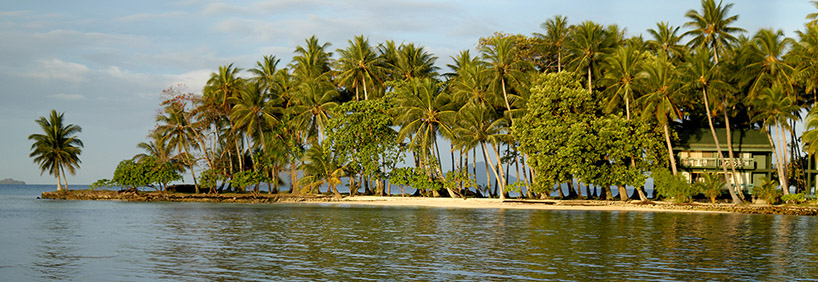 |
Cover Photo (TOP): Closed circuit rebreather diver Jim Rozzi explores the bow deck artillery on the San Francisco Maru.
Above: The beautiful Blue Lagoon Resort our team stayed at for the CCR Invasion.
Below: Divers photograph this Japanese Mitsubishi G4M Navy Type I Attack Bomber (Allied code name “Betty”). Located 150 yards southwest of Eten Island in 60 feet of water. |
|
|
|
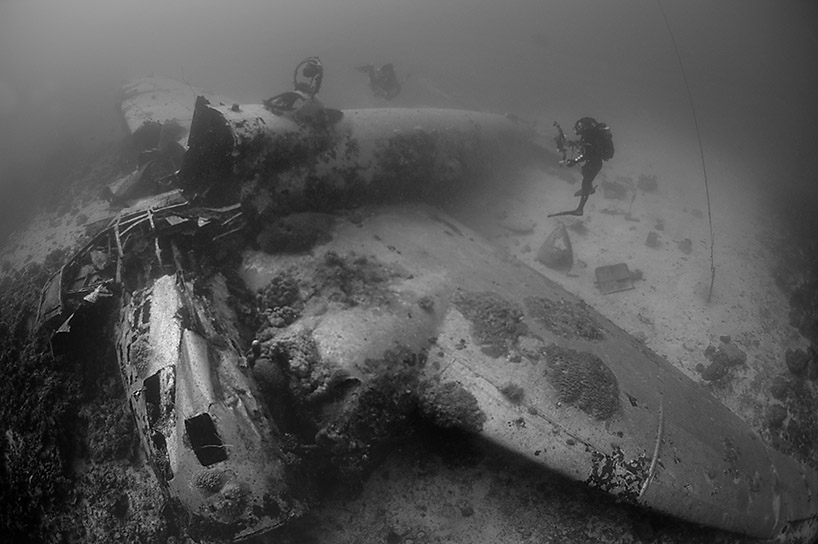 |
| |
The initial air attacks upon Chuuk at 0600 hours were intended to obtain air superiority by engaging Japanese fighter aircraft, disabling airfields, and striking anti-aircraft positions. The following strike at 0700 hours was intended to deliver a massive blow upon enemy shipping with an emphasis on warships. Air strikes continued in fifteen to twenty minute intervals, pounding assigned enemy land and shipping targets throughout the day. March 18th, 1944, included clean-up strikes on missed and damaged shipping targets, airfields, and land based fortifications.
Within thirty-six hours after the initial assault, the Allied forces had destroyed or damaged two hundred and fifty to two hundred and seventy-five Japanese planes, sunk forty-five ships, damaged an additional twenty-seven vessels, destroyed ninety percent of Chuuk’s oil supplies, and damaged over fifty percent of ground installations and airstrips.
Allied losses were minimal at twelve fighters, seven torpedo bombers, and six dive-bombers. A total of twenty-nine Allied pilots and crewmen were lost or reported missing.
Truk (Chuuk) Lagoon 2006 CCR Expedition
Going Under Dive Center’s owner, and closed circuit rebreather diver, Ron Benson envisioned exploring the deeper wrecks of Truk Lagoon without the limitations of using standard open circuit equipment, and breathing gases other than air. Obviously, rebreathers in Truk would be the answer to these problems; but their use would open up a whole new can of logistical problems.
The two dive facilities of Truk provided only basic recreational wreck diving, with minimal excursions to some of the deeper wrecks by using double aluminum 80s and deep air diving.
In 2002, Ron started working closer with Blue Lagoon Resort and Dive Center, located on the main island of Moen. His desire was to bring in additional equipment such as small rebreather cylinders, sodasorb, oxygen, and helium, thus making mixed gas CCR diving possible.
After four years, CCR mixed gas diving is now possible in Truk, extending the standard 20-25 minute deep dive, using air and aluminum cylinders, to 45-60 minutes of bottom time. Non-existent helium mixtures -- because of the high $150-$200 per open circuit fill -- can become manageable at $25. Oxygen fill costs are also reduced to a few dollars rather than the $40 - $50 open circuit cost. With increased bottom times and reduced decompression obligations, CCR diving is the only way to experience some of the world’s greatest wreck diving.
Included in this editorial are some of the interesting and historical wrecks you can visit while in Truk Lagoon. |
|
|
 |
| |
Japanese Destroyer OITE
Takemutsu Matsuda, Captain of the Japanese light cruiser Agano searched the horizon for any possible enemy vessels as the sun’s last rays dipped below the western horizon.
About 160 miles north of Truk Lagoon, the Agano, escorted by the Japanese Destroyer Oite, steamed westward towards Saipan.
Lieutenant Commander W.P. Gruner, Captain of the U.S. Submarine Stark eyes were glued to the periscope as he studied the silhouette of a slow moving ship on the horizon. Dusk a perfect time to attack and escape undetected he thought.
“Load torpedo tubes 1, 2, 3, and 4. Range 2,400 yards, 340 degrees” barked Captain Gruner. Slowly the submarine turned nose forward into position. “Fire 1, 2, 3, and 4 torpedoes” commanded the Captain. The load sound of rushing air followed by the high pitch sound of spinning props echoed through out the submarine.
Lieutenant Yasuhiko Uono, Captain of the Japanese destroyer Oite was also searching the glistening waters as the sun descended when he noticed the prop trails of the four speeding torpedoes heading straight for the Agano.
Captain Matsuda never saw the 3000-pound tubes of death before they slammed broadside into his ship. The Agano shuttered violently as three of the four torpedoes exploded just behind the amidships, knocking the captain and his crew to the deck. Giant flashes of light and fire engulfed much of the ships stern. “Abandon ship,” echoed throughout the Agano.
“Hard to port, full power ahead” ordered the captain of the Oite as he franticly searched the waters for the hidden submarine. Large air powered catapults launched 300-pound anti-submarine depth charges 75 yards port and starboard off the Oite. The water behind his ship mushroomed into giant boils of steam and light as the charges exploded a hundred feet below the surface.
The suns rays fade and darkness engulfed the seas as the sounds of panicked sailors rushed for lifeboats, the only light was the flame from the burning Agano. The Oite dare not light a single search strobe for fear of the prowling U.S. Submarine. Rescue must wait until the morning light.
As the sun’s rays illuminated the eastern skies, the Agano was surprisingly still floating, listing hard to port. The Oite began to pick survivors out of the salty waters and the men still clinging to the floating wreckage. Over all the Oite was able to rescue over 450 sailors, including Captain Matsuda. With the overload of sailors aboard the Oite’s captain had no choice but to run for the protection of Truk Lagoon. On March 17th, the Oite was radioed that a large invasion of Truk was underway and they ordered the captain to continue into the Lagoon to assist with the battle.
Steaming south, the Oite entered the north pass on the morning of March 18th, a day after the initial attack. Still overloaded with survivors from the Agano, the Oite steamed full power ahead towards Moen Island.
March 18th, just before sunrise nine American torpedo bomber pilots aboard the aircraft carrier, Bunker Hill, slipped into their cockpits. Their mission was to search the northern atoll and attack any remaining vessels trying to escape or left floating from the prior days assault. Launching off the aircraft the torpedo bomber’s engines whined as they climbed above the clouds. Within an hour the bombers entered the northern Truk Lagoon. To there surprise they found a Japanese destroyer steaming into the Lagoon.
“Evasive maneuvers” commanded Captain Uono as he attempted to ward off the aerial attack upon the Oite. Under full power the destroyer turned sharp to the port, then to starboard. Anti aircraft fire from the deck, filling the skies with bullets in an attempt to ward off their attackers. The 450 survivors of the Agano were ordered below deck as bullets from the enemy planes strafing attacks took their toll of casualties.
Dropping in from the low clouds, two U.S. torpedo bombers lined up the Japanese destroyer. Skimming 50 feet off the surface of the water, the two bombers screamed into position to unleash their deadly payload. Less than a 1000 feet from the destroyer both planes dropped their 2000 pound torpedoes then banked hard upwards and to the left to escape the onslaught of antiaircraft guns aboard the Oite.
Captain Uono’s eyes followed the white paths of death as they sped towards his ship. He had no time to maneuver away as the torpedoes slammed into the Oite’s port side. One impacted just behind the bow anchors and the second directly at the ships engine room. A deafening explosion rocked every inch of the ship as it tore metal from metal and bone from flesh. Sailors below deck were instantly killed by the explosion or laid dazed and confused. Sailors above deck were either blown into pieces or hurled from the ship like papers in a tornado. As the water rushed in, no sailor could even save himself.
As the bombers raised away from the destroyer the pilots watched as their torpedoes smashed into the Oite’s side. The following massive explosions engulfed the ship with smoke and flames as the bow section buckled under the pressure. The Oite split in half and sank in less than one minute, taking over 600 Japanese sailors to the bottom of Truk Lagoon with it. |
|


|
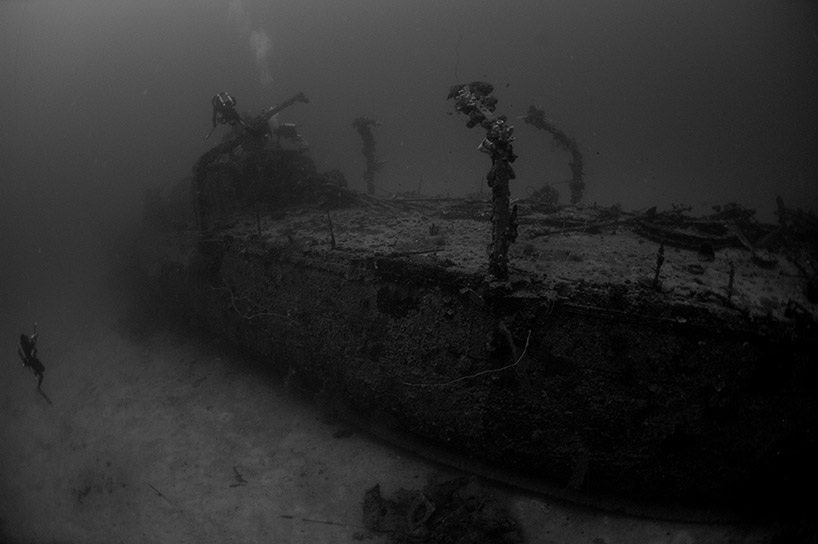 |
Above Illustration: Artist rendering of how the Japanese Destroyer Oite sets on the sea floor.
Above photo: The stern section sets upright at a max depth of 202 feet.
Below Left: Ships equipment scattered around on the inside of the ships stern section.
Below Right: One of the Oite's props half sunken in the seafloor sand. (click images to enlarge) |
|
|
|
|
| |
Diving the Oite
Due to its distance from the main diving wreck zones and increased depths, the Oite is seldom explored. As the Oite split in half during the sinking, the section from just aft of the pilothouse to the bow turtled and smashed hard into the sand floor, crushing all the superstructure and deck guns underneath the hall. Tilted slightly to the port side it is possible to squeeze up underneath the bow section and into some of the bow sections. The forward bow torpedo explosion is easily seen from the massive hole and destruction. The stern of the Oite from just aft of the engine room sets upright on the sand floor. The main deck sets at 180 feet with the sand at 202 feet. The Oite has twin brass props half buried in the sand. Antiaircraft guns and a large main battery gun points towards the sky. Lifeboat davits and a depth charge rack can be examined on top the deck.
Many artifacts including china, bullet casings, the ships bell (or maybe the Agano’s bell) is stowed away just below the stern battery gun, multiple human remains can be found within the wreckage along with some books. Much more exploration needs to be conducted within the bow of the wreckage, but due to the large amounts of twisted metal and fine silt, it could be rather dangerous. |
|
| |
 |
Above: CCR divers inspect the stern section of the Oite. Max depth 202 feet.
Below: Divers look through the large damaged section of the Oite's bow. |
|
|
|
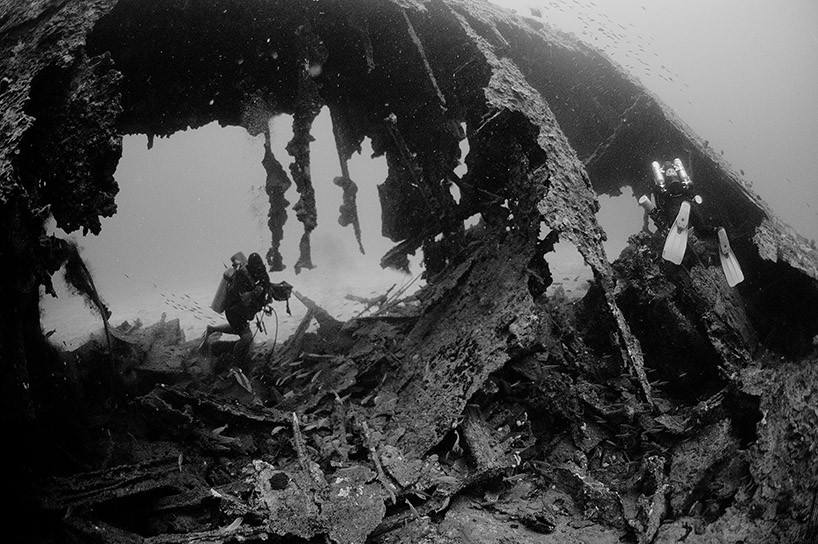 |
|
| |
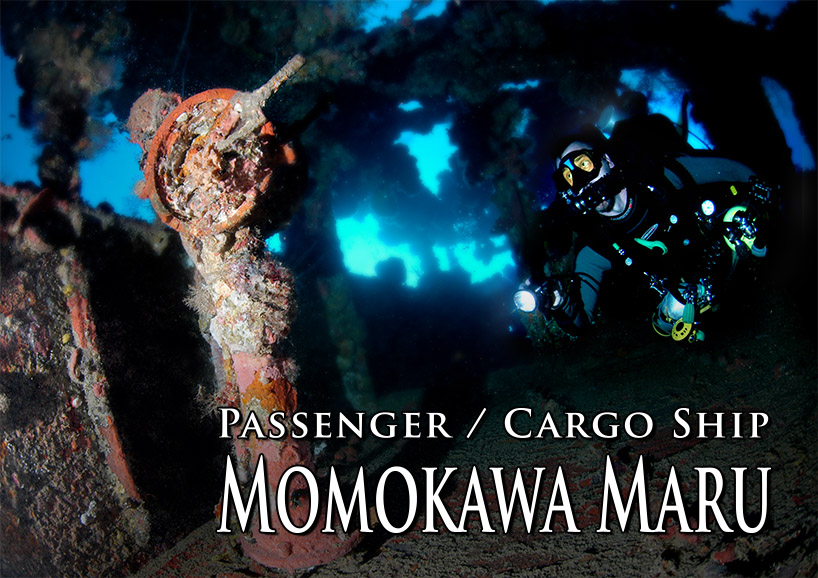 |
| |
Momokawa Maru
Built in 1941 as a cargo ship and requisitioned by the
Japanese Navy in 1943, the 354 foot, 3,829 ton Momokawa Maru was assigned as a military supply ship.
During the initial attacks on March 17th, the Momokawa was found anchored in the northern extremes of the 4th Fleet Anchorage east of Dublon Island.
The Momokawa was attacked several times on the 17th, but received minimal damage. Clean-up attacks on the 18th would send her to the bottom with a direct hit from a 1,000-pound bomb placed into cargo hold no 5. Retreating attack planes reported seeing the ship listing to port with the stern engulfed in flames. |
|
 |
1: Hold #1: Aircraft parts, tires, bombs, metal sheets, and barrels.
2: Hold #2: Tabby aircraft, trucks, aircraft engines, and fuel tanks.
3: Hold #3: Trucks, aircraft engines, tires, and fuel tanks.
4: Entrance into engine room through skylight.
5: Hold #4: Empty.
6: Hold #5: Artillery shells. |
|
|
| |
Today the Momokawa Maru can be found lying on her port side in 154 feet of water. Descending onto the bow and into cargo holds number one you will discover piles of aircraft parts, barrels, tires and bombs. All the cargo has shifted towards the port and some has spilled out onto the sea floor.
Cargo hold number two contains the remains of the Douglas L2D, Navy type O transport aircraft “Tabby” along with some fuel tanks, aircraft engines, aircraft props and trucks. Again most of this is located in a large shifted pile.
Cargo hold number three also contains many aircraft parts, tires, aircraft belly fuel tanks and a couple buried trucks.
Swimming towards the stern you can enter the pilothouse either through the front windows or upwards through the port doorway. Inside the ships main telegraph and some other interesting artifacts can be found. |
|
| |
 |
Above: Lying on her port side, the Momokawa was propelled by a massive single prop.
Below: Large aircraft prop sticks out of an assortment of tires, barrels, and bombs (cargo hold #2). |
|
|
|
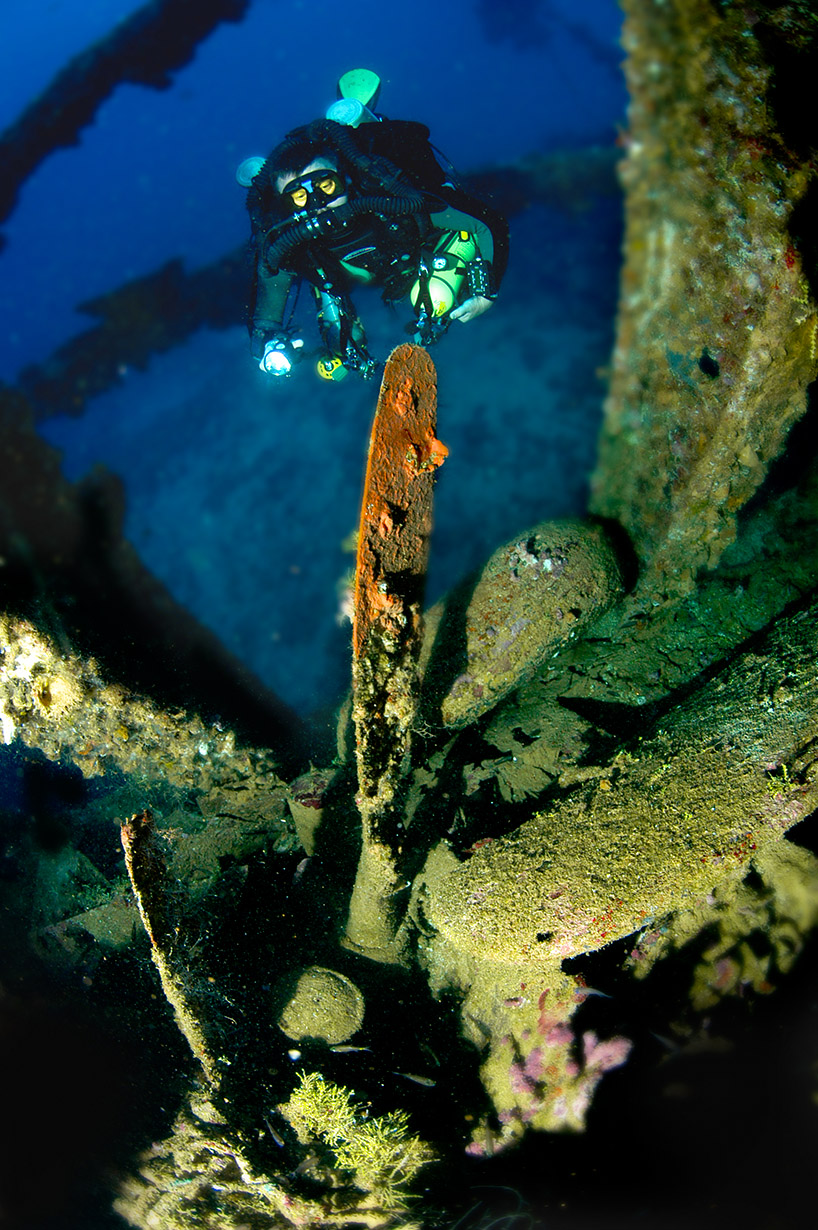 |
| |
The Momokawa has an interesting engine room but the lower levels can become confusing because of her lying on the port side. A diver must remember that, up is not the way out.
Cargo holds number 4 and 5 are mostly empty except for some artillery shells. The area of cargo hold number 5 has received major damage from the 1,000 pound bomb explosion.
The stern of the ship contains a small artillery piece and an access hatch entrance for the below deck stern rooms. Swimming around the stern you will discover a massive single propeller and rudder encrusted with soft corals. (right photo)
Swimming along the sea floor at 150 feet you can discover many artifacts and pieces of machinery that has fallen from the cargo holds, pilothouse and crews quarters.
The starboard side of the ship is covered with soft corals, sponges and an array of marine life. |
|
| |
|
| |
|
 |
| |
Hoki Maru
Originally built in 1921 by the Union Ship Corporation of Scottland, the 450-foot, 7,112-ton cargo ship was christened the M/V Hauraki. In 1940 she was requisitioned by the British Ministry of War and assigned special wartime duties.
July 1942 the Hauraki departed Sydney Australia bound for a port in Colombo when Japanese raider ships, the Aikoku and Hokoku, seized her. Her crew was taken to prison camps in Singapore while the ship was delivered to Japan.
After refitting the Haruaki was renamed the Hoki Maru and commissioned as a special transport vessel for the Japanese Navy.
The Hoki Maru was anchored just southeast of Eten Island on the morning of March 17th. First attacked by the Essex single engine torpedo bombers the Hoki received minimal damage. Dragging her anchor in a desperate attempt to escape she was again attacked by torpedo bombers from the Bunker Hill.
Twin torpedoes struck the forward holds one and two. These holds were loaded with hundreds of 55 gallon gasoline barrels. The detonation from the torpedoes within the barrels of gasoline triggered such a massive explosion that it almost desinigarted most of the ship forward the pilothouse. The massive explosion and fireball also consumed most of the pilothouse, galley, and engine room and crews quarters. Ripping the ship in half the flames were quickly extinguished by the flooding seawater as she sank within minutes. |
|
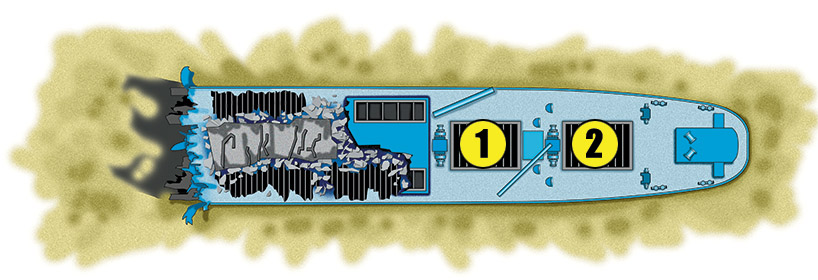 |
1: Hold #4: Mines, depth charges, bombs, and radial AC engines.
2: Hold #5: Bulldozers, movers, trucks, tractors, and diesel roller. |
|
|
| |
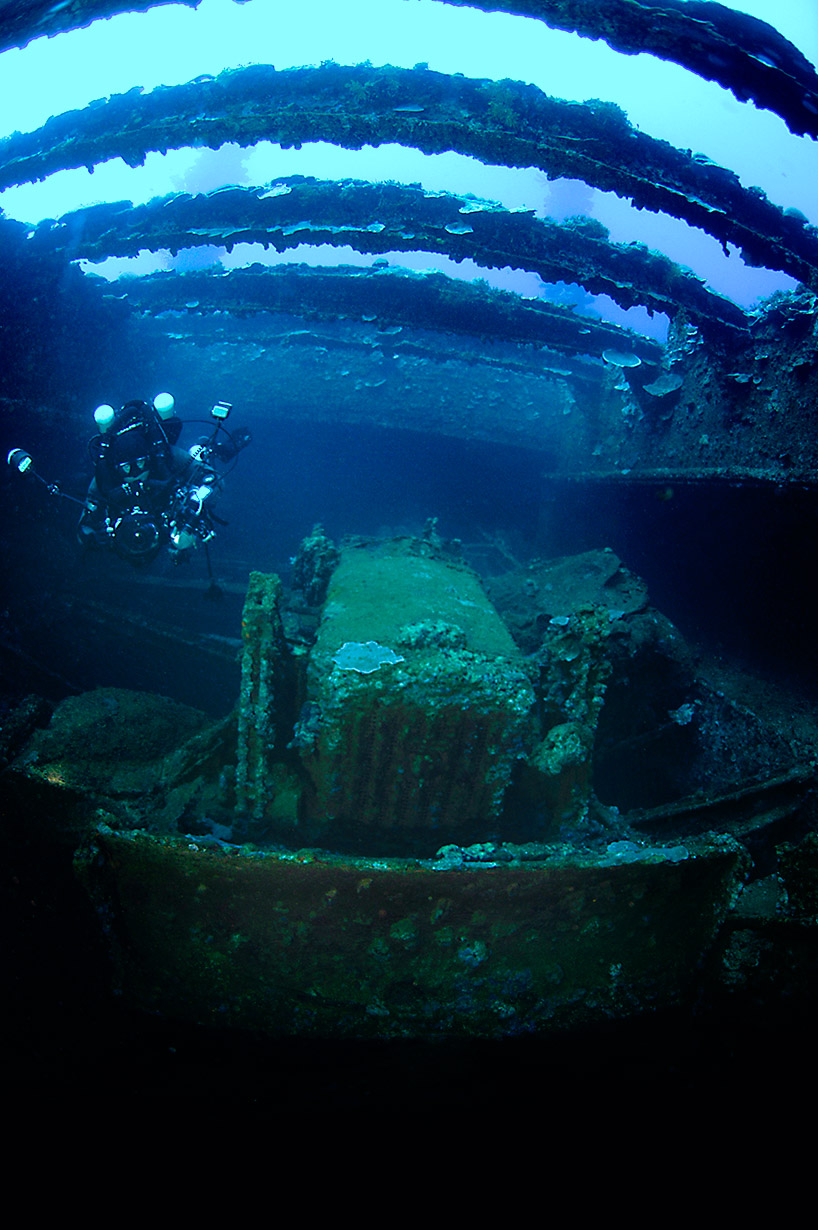 |
Above: CCR diver Jim Rozzi examines the large bulldozer in cargo hold # 5.
Below: Isuzu-type 94 trucks located on level 2 in cargo hold #5. |
|
|
|
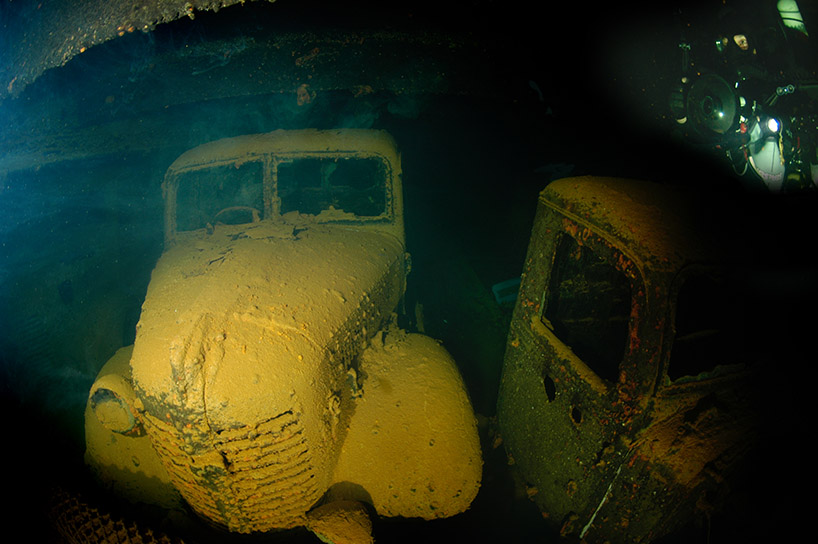 |
| |
Today the stern section of the ship lies upright in 165 feet of water. Most of the ship from the bow to the amidships is a pile of twisted metal and not worth exploring.
The pilothouse, galley and crews quarters have received major damage. The primary reason for visiting the Hoki Maru is located in hold number 4 and 5 towards the stern of the ship.
Hold number 4 contains many radial A/C engines, bombs, depth charges, beer bottles and mines
Descending through the hatch cover beams of cargo hold number five, you will come upon a large bulldozer supported on hatch cover beams. (top right photo) Swimming below deck towards the starboard side you will find an interesting tractor. (bottom right photo) Continuing below deck and towards the stern a strange white mist encompasses several Isuzu type 94 trucks. Continuing around towards the port side of the cargo hold several more flatbed type trucks come into view along with a diesel steamroller.
Descending over the stern, large twin screws and rudders come into view with the seafloor at 165 feet.
Exploring in the masses of twisted metal below the pilothouse, crews quarters and partially collapsed engine room some gauges, machinery and human remains can be located. (left photo)
Caution must be taken not to stir up the silt in lower sections of this wreck for it contains large amounts of some type of caustic chemical that can cause skin burns and eye irritation. |
|
| |
Below Left: Farm-type tractor located on level 2 in cargo hold #5.
Below Right: Hoki Maru engine room guages |
|
|
|
|
| |
|
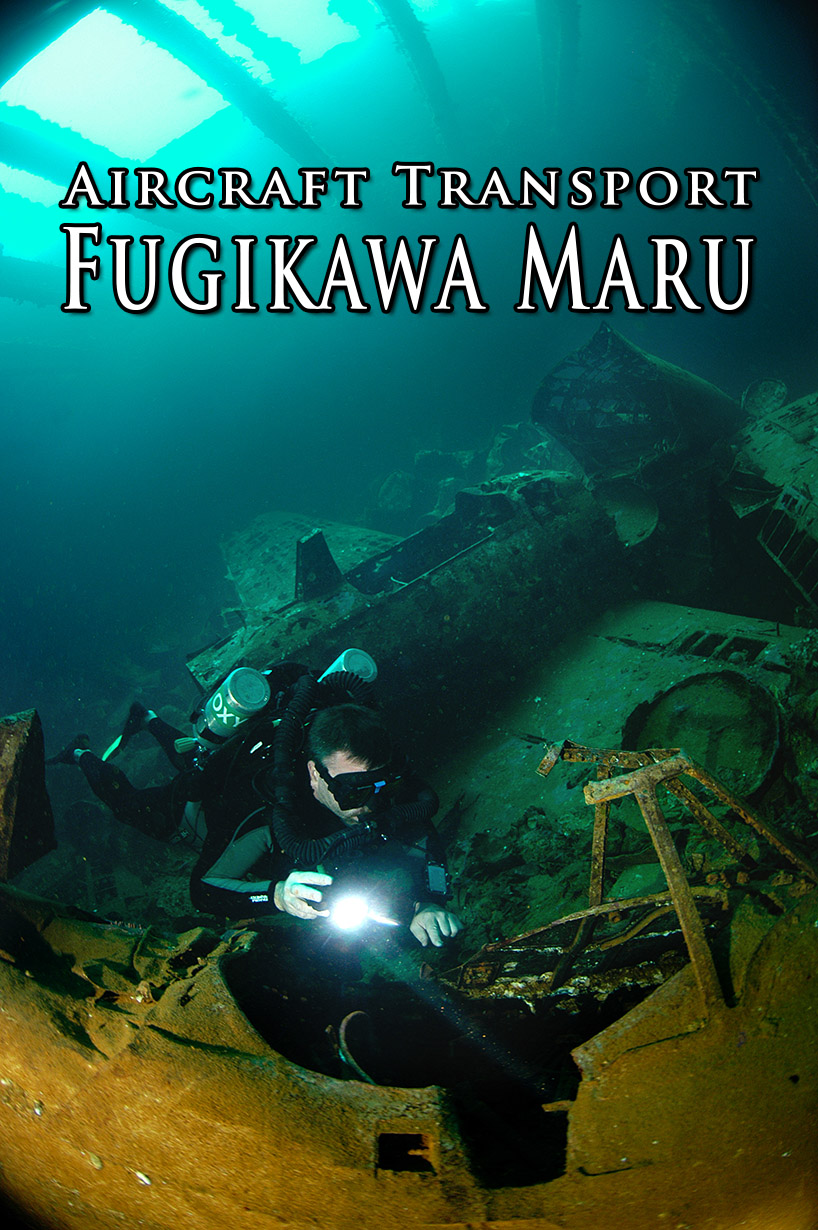 |
| |
Fugikawa Maru
Built in 1938 and requisitioned in 1940 by the Japanese Navy as a special aircraft transport vessel, the 437 foot, 6,928 ton Fugikawa Maru served many roles during WWII.
On the morning of March 17th, the Fugikawa was anchored just off the southeastern side of Eten Island. In the early morning light her skeleton crew was attending to standard morning duties. Many of the crew was ashore working on construction details.
As all hell broke loss with the arrival of the allied air force from the north, the Fugikawa became a setting duck, unable to pull anchor and escape because of the lack of crew. It would be only a matter of time before the inevitable torpedo would breach her hall. So it would be at 1420 hours the attack aircraft of the Bunker Hill strike 3E force recorded a direct torpedo hit with a large smoke and fire burst to follow.
On March 18th, the Fugikawa was found heavily damaged but still floating, anchored in the same location by the clean-up attack aircraft. Nothing a 1,000-pound bomb on her port quarter would not take care of, sending the Fugikawa Maru to her final resting place. |
|
| |
 |
1: Hold #1: Aircraft parts, machine guns, torpedo, and boat motor.
2: Hold #2: Zero aircraft fighters, fuel barrels, and aircraft wings.
3: Hold #3: Empty.
4: Hold #4: Barrels.
5: Hold #5: Gas cylinders, beer bottles, and hose sections.
6: Hold #6: Bottles, china, mess kits, and water tanks. |
|
|
| |
 |
Above: CCR diver Ron Benson illuminates a large air
compressor located in the lower level of the engine
Below: Ron Benson examines the Fugikawa Maru’s pressure and electrical wall. |
|
|
|
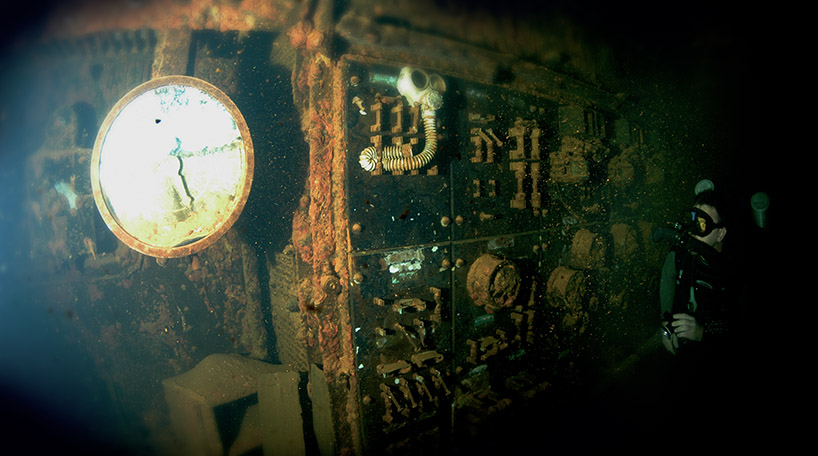 |
| |
Today, the highlight of the Fugikawa is the Japanese Zero aircraft fuselage located in cargo hold #2 and the ships engine room accessible through skylights just behind the smoke stack.
Searching cargo hold number two you will discover the remains of four of the famous Japanese Zero fighter aircraft along with wing sections and some person artifacts.
Exiting the cargo hold and swimming towards the stern you will pass the upper super structure and over the engine room.
Descending through the engine room skylight you will encounter a large triple level engine room separated by grated catwalks and walls. Winding past the massive engine cylinders and to the second level you will discover a very interesting workshop containing a large air compressor, nicknamed R2D2, a workbench, lath, supply rooms, and tool chests. Further exploration along the forward engine room and down to the third level you will discover a wall of electrical contacts, pressure gauges and the ships engine room telegraph. (see above) Additional exploration will revile a multitude of gauges, tools, and equipment.
Exiting the engine room and swimming towards the stern are two more cargo holds containing many different sized gas cylinders, beer bottles, and debris.
The Fugikawa has been fitted with two large 6” deck guns, one on the bow and another on the stern. Descending over the stern towards the sea floor, the rudder and massive single screw propeller come into view. (right)
The Fugi’s engine room is a must-do for exploration and photography. |
|
| |
|
Above Left: Pair of pilot binoculars located beside an airplane cockpit in cargo hold #2.
Above Right: Thousands of beer bottles scatter the second level of hold #5.
Below: A diver poses behind the Fugikawa’s massive single prop. |
|
|
|
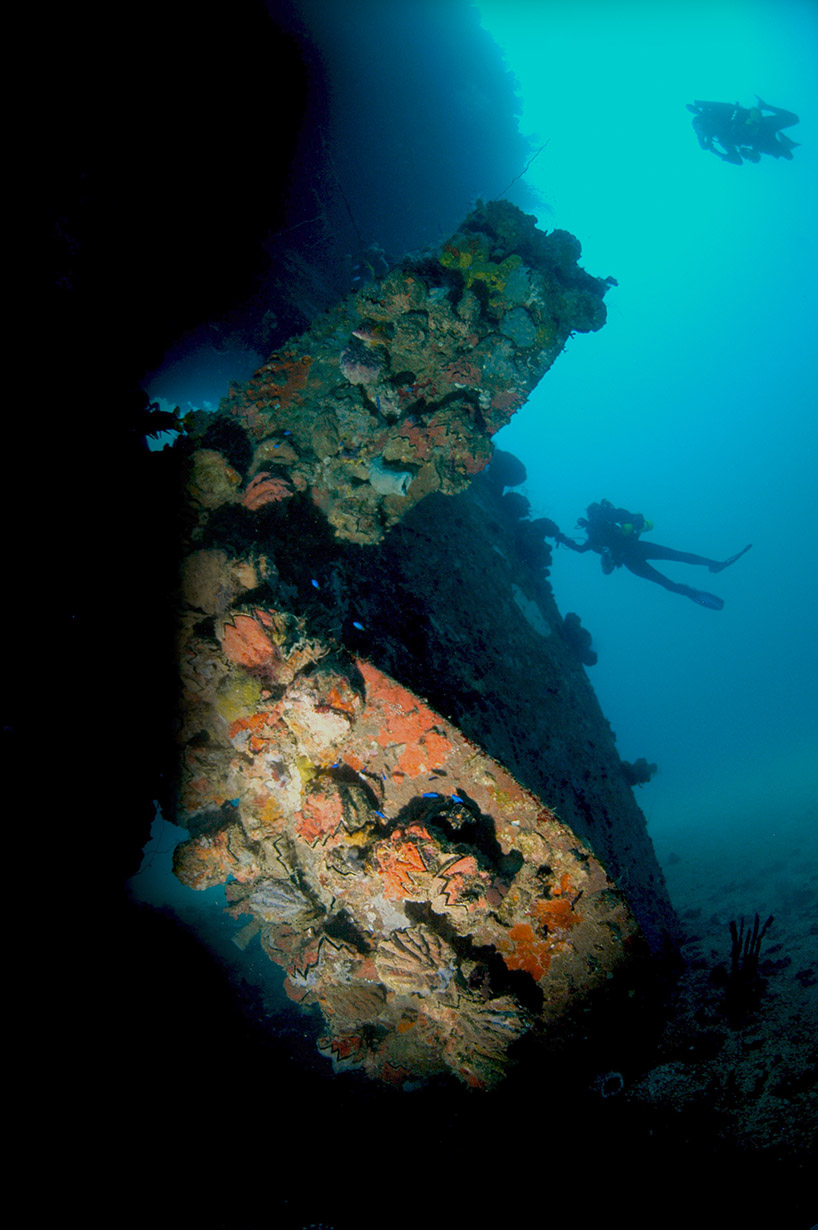 |
|
| |
 |
| |
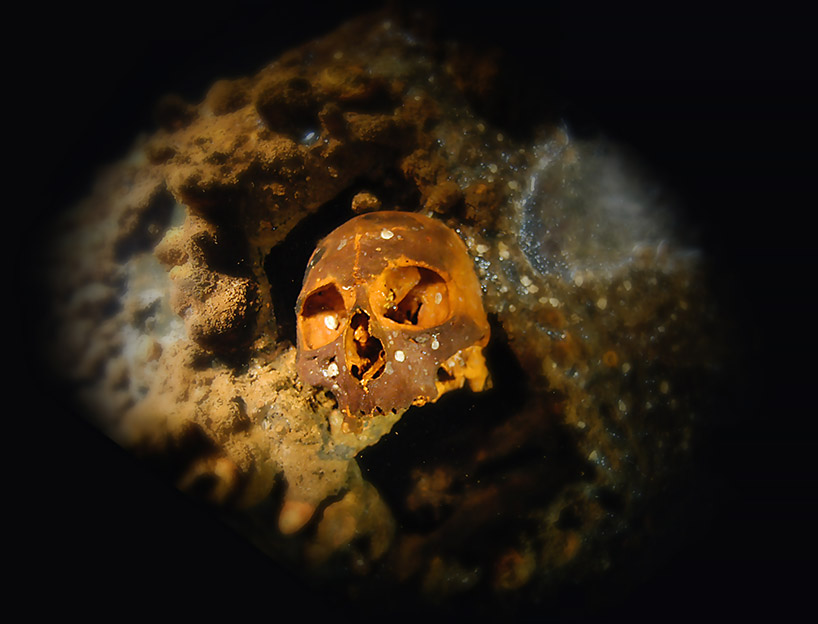 |
Above: Signs of the sacrifices of war, a Japanese sailor’s skull and
bones are located deep within the engine room of the
Yamagiri Maru.
Below: Scattered throughout cargo hold #5, these 14-inch diameter artillery shells were destined for one of the large Japanese battleships, Yamato or Musashi. |
|
|
 |
| |
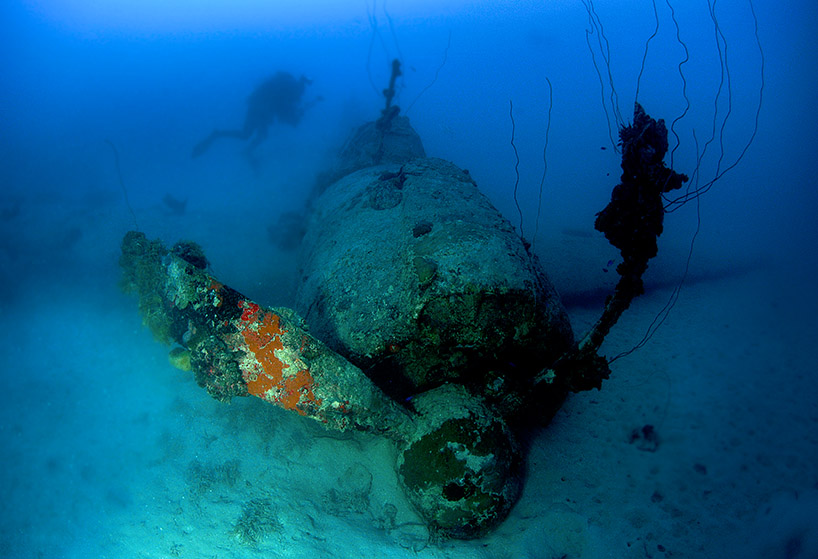 |
Above: Japanese torpedo bomber “Jill” sits in 120 feet just off Eten Island
Below: Japanese-type 95 light battle tanks are located on the
starboard foredeck of the San Francisco Maru. |
|
|
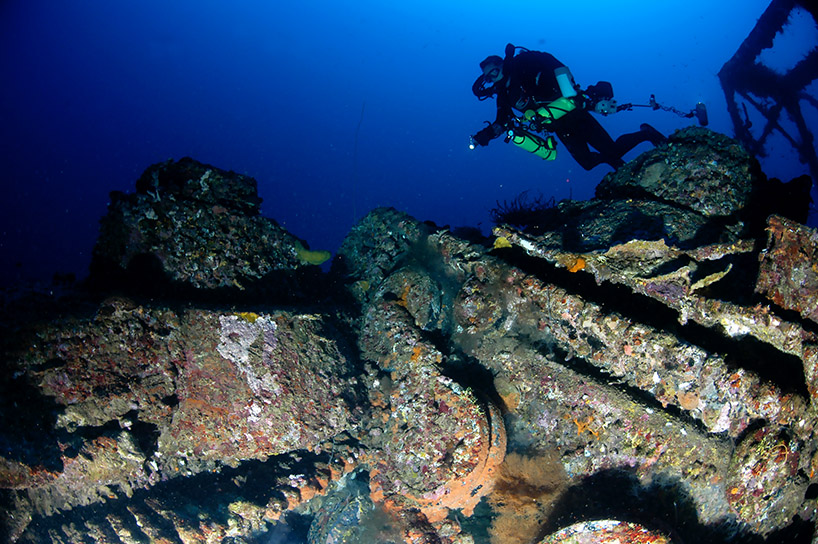 |
| |
 |
Above: Exploring deep into the third engine room level of the Heian Maru, CCR diver Ron Benson discovers this engine room telegraph and engine pressure gauge panel.
Below: A lone gas mask sits upon a pile of small arms debris, as
CCR diver Jim Rozzi drops into cargo hold #1 of the Nippo Maru. |
|
|
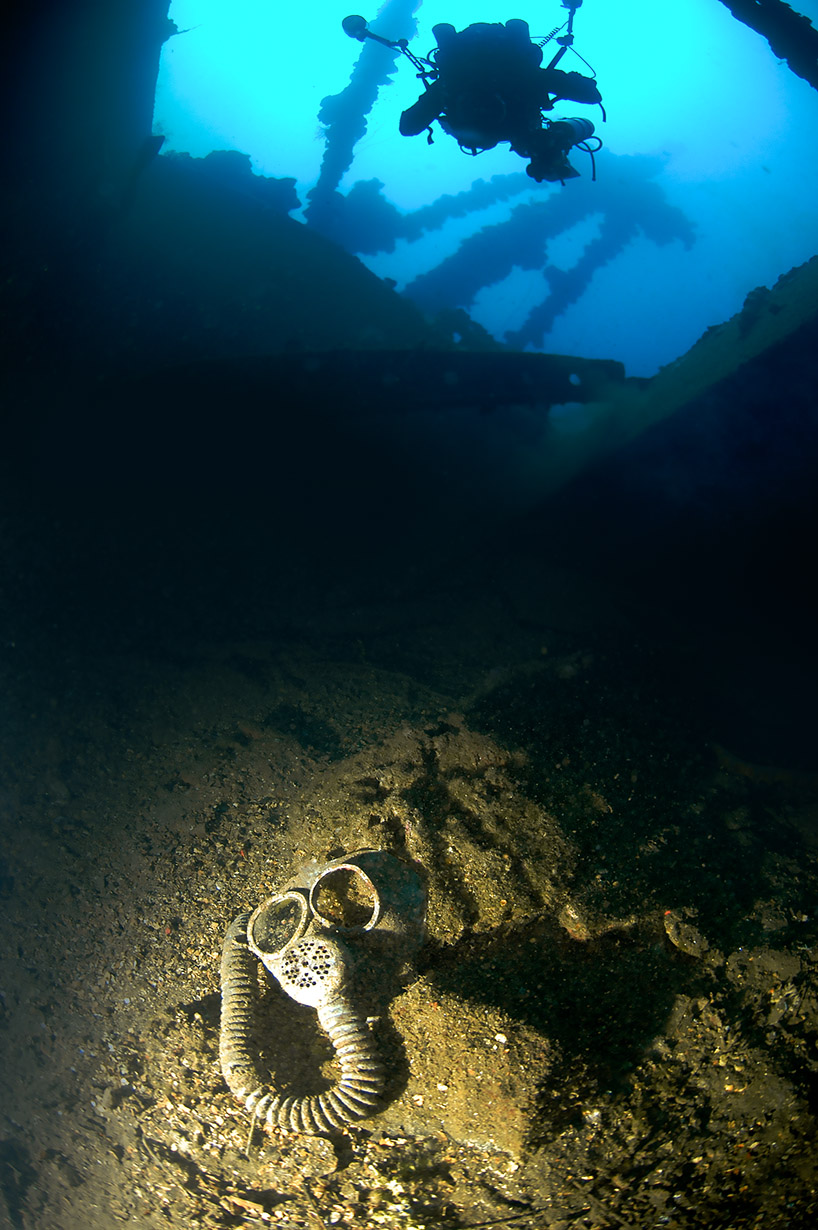 |
| |
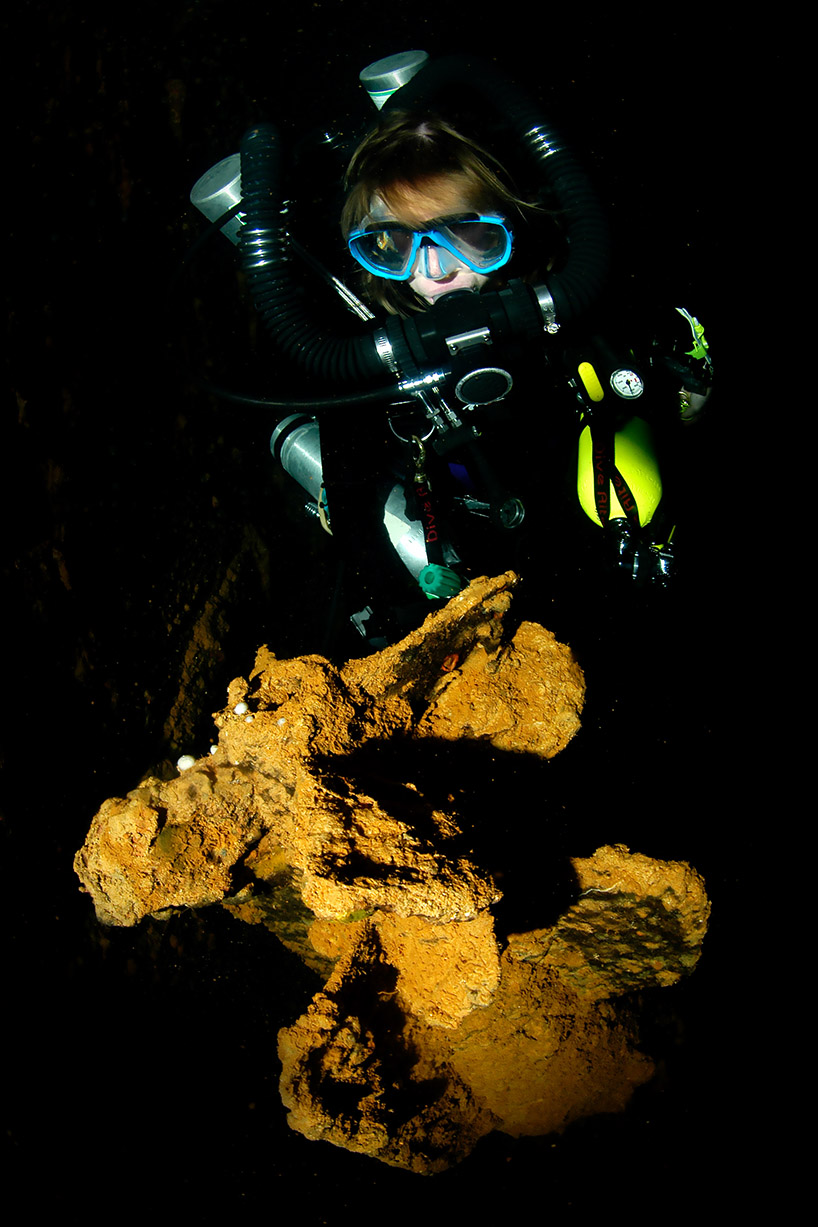 |
Above: CCR diver Amy Ferguson examines the prop of a 25-foot
long, 2000-pound torpedo, located within hold #2 of the Heian Maru.
Below: Meg CCR diver Jim Rozzi and underwater camera set-up. |
|
|
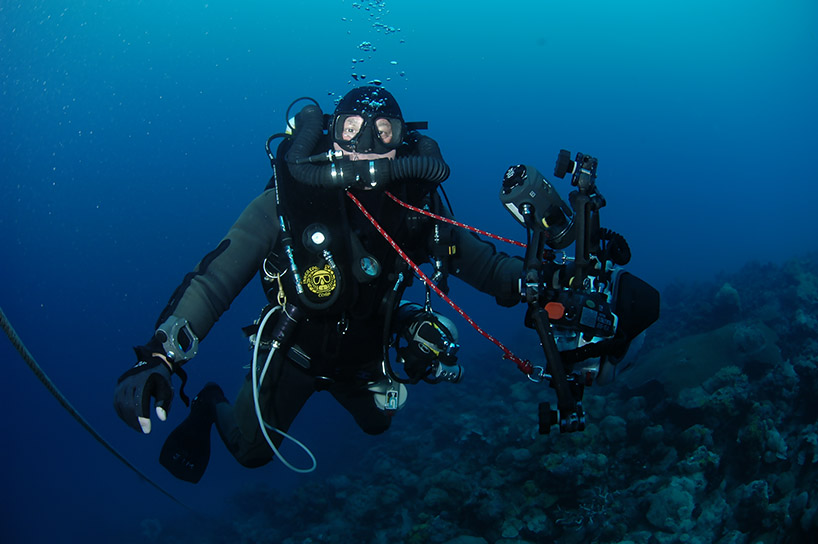 |
| |
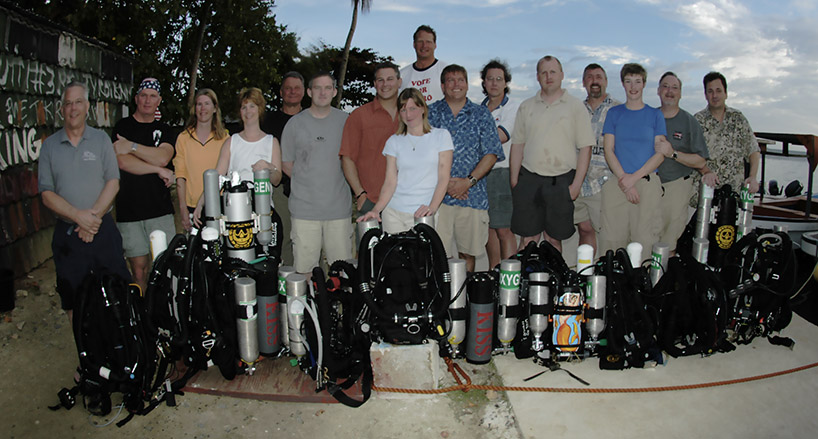 |
Above: CCR Divers: (Left to right)
Lee Selisky, Curt Bowen, Maria Nordlund, Patty Mortara, Jim Rozzi
Chris Jackson, Rick Peters, Amy Ferguson, Rob Infante, Bob Ferguson, Keith Holmes, Bill Mattson, Ron Benson, Mel Clark, Curt McNamee, Ren Mortara
Below: Author standing on Blue Lagoon Resort beach for a Long exposure moonlight only night photo. |
|
|
 |
|
| Contact Curt Bowen |
|
| |
Do NOT dive TRUK LAGOON without this book! (click book to order)

|
| |
|
| |
|